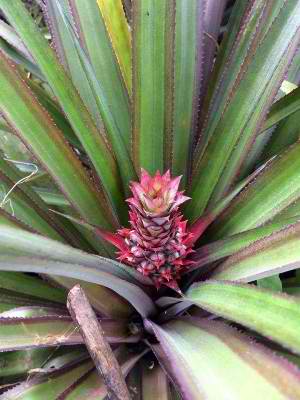The Red Spanish Pineapple is one of the four varieties of pineapple that are being grown in the Philippines, along with Smooth Cayenne or Hawaiian, Queen or Formosa, and Cabezona. But due to the fibrous, sweet and course taste of its fruit, the Red Spanish Pineapple is mainly grown for its fiber.

Compared to the other varieties, the Red Spanish fruit is relatively small weighing around 0.91-1.4 kg. Externally, it is orange-red while its fibrous flesh is pale yellow. The fruit turns hard when mature, and breaks off easily from its base during harvesting. This variety takes about 18 months to reach maturity and thrives well in open fields with sandy clay soil. The plant grows spiny leaves up to two meters in length which yield excellent fibers for handweaving.
Since the Red Spanish pineapple is mainly used for the production of the Piña cloth, the fruits, which are small, are mostly thrown away during the harvesting of the leaves.
Not wanting to see this champion crop go to waste, Agriculture Secretary Manny Piñol tasked the Bureau of Agricultural Research (BAR) and the Bureau of Plant Industry (BPI) “to lead research initiatives on how to improve the size and the quality of the Spanish Red Pineapple fruits so that farmers will make additional income.”
In response, BAR, as the lead agency for research in agriculture, immediately convened concerned stakeholders along with its pool of experts, particularly, representatives from the Aklan State University (ASU), DA-Regional Field Office (DA-RFO) 5, DA-RFO 6, and the Philippine Fiber Industry Development Authority (PhilFIDA) to discuss and finalize the research and development (R&D) component studies to improve the size and quality of the Red Spanish pineapple.
According to BAR Director Nicomedes P. Eleazar, as a result of that meeting, the group was able to come up with a concept note and an action plan showing specific R&D activities to be implemented by concerned agencies specifically on how to improve the fruit size without compromising the quality of its fiber. He added that initial discussion was also facilitated on the issues and concerns of the textile fiber production from the Red Spanish pineapple as this is the main use of the plant.
As discussed, the R&D components of the program will include: 1) profiling and market research of Red Spanish pineapple production (to be led by DA-RFO 6 and ASU); and 2) looking into the cultural management studies for production of large and sweet Spanish Red Pineapple, including cost-benefit analysis of producing/processing products (to be led by DA-RFO 5 and ASU).
This R&D initiative is Secretary Piñol’s proactive response to revive the once lucrative piña fiber Industry. “The piña fiber weaving was once upon a time a lucrative industry, especially in the province of Aklan where the Spanish Red variety of pineapple, known for its strong fiber, grows well. In recent years, however, the industry has suffered from very low supply of the fiber and the dwindling number of weavers who only earn as much as Php300 a day for the difficult work which strains the eyes,” said the Agriculture secretary. ### (Rita T. dela Cruz) – bar.gov.ph

